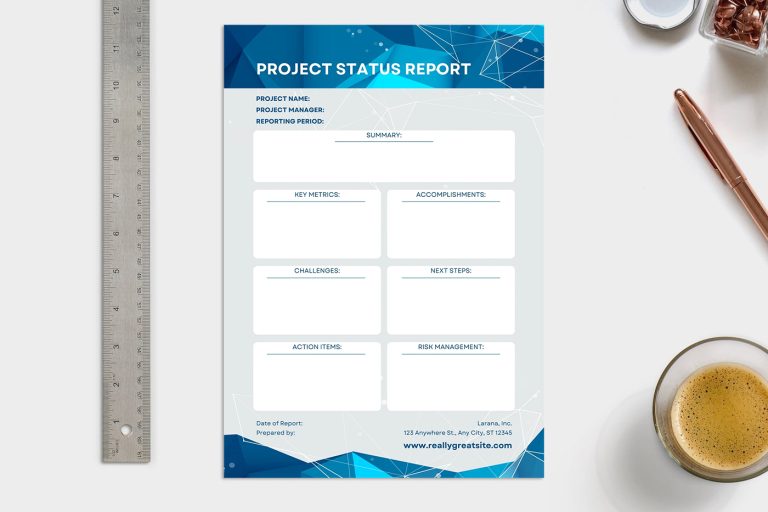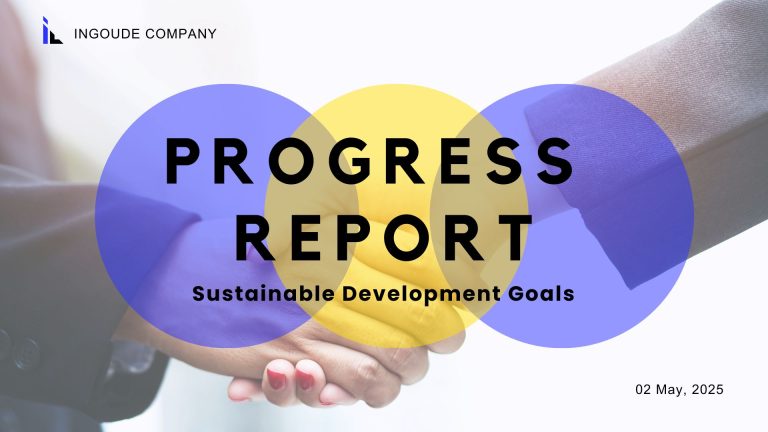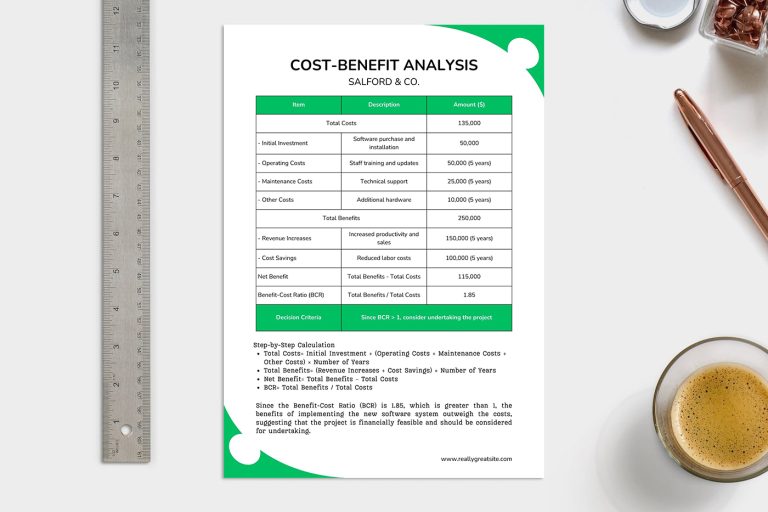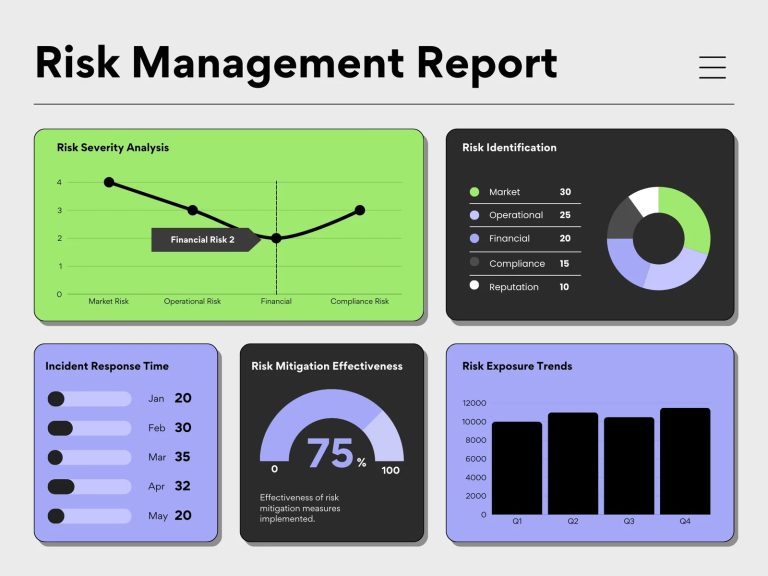How To Write a Project Report: Guide with Types, Templates & Tips
Project reports are essential for planning and managing your projects. You can create a board, online presentation, or a brochure with your project report to easily access your plans and results - but first, you need to understand what these reports involve.

In this article, we'll explain what a project report is, and how to write, organize, and present it for others to access. Read our guide to find everything you need to know about project reports!
What is a project report?
A project report is a document that contains the history of a specific project within an organization. It describes the project’s goals, current status, team efficiency, and what they've already accomplished. Additionally, it also points out any problems faced during the project, how they were solved, and what was learned from them.
Project managers create these reports to keep everyone involved in the project informed: team members, executives, clients, and other stakeholders. By using project status reports, these parties can track whether the project is progressing as planned and is likely to meet its objectives.
Key takeaways
-
A project report is a document outlining a project's goals, progress, challenges, and lessons learned to keep stakeholders informed.
-
It includes an executive summary, progress updates, resources, timeline, major changes, financials, team performance, and risks.
-
Types include status reports, progress reports, cost-benefit analyses, time tracking, and project completion reports.
- They improve project management, task assignment, and collaboration, and provide valuable insights for future projects.
What should be included in a project report?
Here are the main components of a typical project report:
Summary
Start with a brief summary that includes the main points without going into all the details. You are creating the report for executives, and today’s leaders often don’t have time to thoroughly read the entire document. The executive summary should summarize the report’s content in two to three paragraphs.
Progress update
Provide an update on how the project is progressing using specific, measurable data. This helps others understand the current status and budget.
Check resources
By resources, we mean tools, materials, and people. List what you have, what you've used, and what you need more of.
Time plan
When planning a project, a time frame is usually set. In this section, update the project schedule - either make the completion timeline more concrete or adjust it to reflect the project's progress. Be honest about deadlines and any possible delays.
Major changes
Mention any major changes from the original plan. We all know that these issues can arise, and updating the plan is common. It's a good idea to use flipbooks from Publuu, as you can upload a new version of the report, while keeping the same link, which is convenient for revisions.
Publuu’s online report example
View more online flipbook examples
MAKE YOUR OWN
Financial issues
Detail how much has been spent and how much you expect to spend. Justify any budget overruns. You can use statistics and infographics for clarity, which will also be helpful for tracking progress long-term.
Team performance
Describe how well the team is performing. Highlight any challenges they’ve faced and indicate progress, preferably with measurable, concrete data.
Potential issues
List any issues that could affect the project. Explain how serious each risk is and how you plan to deal with it. In some cases, the risk report can take up a major part of the entire report.
Related topic: What is a financial plan?
How to write a project report in 5 easy steps
Below you'll find a guide to writing a project report:
1. Define the report objective
Think about the key issue in your project: what do you want to show, and what is most important in your project report? If your goal is to show the progress of your work, these are the crucial ideas you need to focus on - remember that the data must be measurable and detailed.
2. Know your target audience
Consider who your target audience is: your executive, your client, or another stakeholder? It's important to tailor the language and presentation of the data to the audience, avoiding jargon and unnecessary details.
3. Gather information
Project reporting must be based on accurate data. Look for information that supports your conclusions and provide relevant indicators. Use case studies, surveys, or personal testimonials to add depth and credibility.
4. Plan the structure
Organize your report into sections:
-
Summary: Give a brief overview of the entire project, so the readers can understand the key points quickly.
-
Introduction: Explain the purpose of the report creation and the sources you used.
-
Main content: Describe the details, presenting the most important issues in chronological order. Also, use charts or graphs to help readers visualize the data and ideas, and to better understand the project's status.
-
Conclusion: Summarize the most important points, main ideas, and comments for the reader, and provide any final insights or recommendations.
5. Check everything carefully
Review your report several times to make sure everything is clear and correct any errors. You can also ask a co-worker or professional editor review it to catch anything you might have missed.
Related topic: How to Create an Effective Project Presentation
Why is a project report important?
Writing reports might seem like an unnecessary task, and it may feel easier to simply tell updates to your boss. However, this is not always the best approach, because:
![]() Reports help you learn more about the effectiveness of your project.
Reports help you learn more about the effectiveness of your project.
Like in a diary, you document what you did and what you learned from your experiences. You also note any mistakes made by you or your project team, which can be helpful to refer to in the future.
![]() Reports help you assign tasks.
Reports help you assign tasks.
For example, if a status report shows that the chief designer is consistently behind schedule, it's a good idea to bring this to HR. Thanks to the reports, you can learn how well your team members have performed in the past.
![]() Reporting makes collaboration easier.
Reporting makes collaboration easier.
With reports, everyone knows what they are working on and what the results are. A clear division of responsibilities will make your work easier in the future.
![]() They show that you can work well.
They show that you can work well.
A well-prepared report shows that you are thorough and can explain complex information. Relying on them, you can analyze data and evaluate progress effectively.
![]() They are useful for the future.
They are useful for the future.
You can go back to project reports when you start a new project and refer to what you already know and have learned from the past actions. By analyzing these reports, you may find better solutions for the future projects.
Types of project reports
1. Project status report
This type of report shows the current status of the project, covering goals, progress, challenges, and next steps. It can be created weekly or monthly to reflect the ongoing status of the project.
2. Project progress report
This report focuses on the detailed, quantitative progress of individual tasks and milestones. It shows specifically what has been accomplished - for example, how many pages of the book have already been edited. You can use interactive tools like those from Publuu to track the progress in real-time, such as linking to a spreadsheet with project data.
CREATE YOUR PROJECT REPORT NOW!
3. Cost-benefit analysis report
Such a report is typically created at the beginning of project implementation. It evaluates whether continuing the project is worthwhile by comparing costs and potential benefits. Benefits don’t always mean profit margins; based on this analysis, project management must decide whether to continue the project.
4. Time tracking report
This document records the time spent on project activities by team members, often in the form of a timesheet. Today, thanks to online tools, it is no longer common to log down data exactly, but in a factory, for example, it is often useful to report time records.
5. Resource project report
This type of report provides an overview of how resources (labor, equipment, materials, budget) are allocated. It may be part of an inventory or summary, focusing on employees or available labor costs.
6. Risk report
This document analyzes potential risks, including their likelihood, impact, and possible solutions. Such a report can often be used independently and can apply for different projects.
7. Deviations report
This type identify errors and help you correct them. It shows differences between planned and actual performance in areas such as budget, time and scope. With this data, future efficiency can be increased as you use project reports to learn from your mistakes.
8. Performance report
This document evaluates the overall performance of the project compared to predetermined targets and indicators. It helps evaluate success and discover errors in project performance. For example, you can report if you have achieved the maximum number of sales and what went wrong.
9. Project completion report
Such a document summarizes the entire project lifecycle upon its conclusion. It describes the achievement of goals and provides recommendations for future projects.
Read more: What is an annual report?
Example of a project report
Let's take a look at a sample project status report and see what you can include in the report:
General Information
Project Title: Soil Analysis in Lyon Project 2024
Project Manager: Dr. Janine Gorsky
Timeframe: Started: 01. Mar. 2024 - Estimated End: 21. Oct. 2024
![]() Clearly state the name of your project and assign a unique identifier. In many organizations, this makes it easier to file and track the project down. Name the person responsible for overseeing the project and specify the start and estimated end dates.
Clearly state the name of your project and assign a unique identifier. In many organizations, this makes it easier to file and track the project down. Name the person responsible for overseeing the project and specify the start and estimated end dates.
Executive Summary
"This project aims to analyze soil samples from various locations in Lyon to assess soil pollution in heavily populated areas. The collected data will be used for health research and environmental monitoring by the IEMC."
![]() Provide a brief summary of the project's purpose, goals, and key findings. This should be simple and easy to understand for non-experts. Note how we avoid phrases like "micro-environmental" or "suffusion". In this example, we'd describe the methodology and research methods.
Provide a brief summary of the project's purpose, goals, and key findings. This should be simple and easy to understand for non-experts. Note how we avoid phrases like "micro-environmental" or "suffusion". In this example, we'd describe the methodology and research methods.
Project Goals and Objectives
"The project aims to gather and analyze 240 soil samples to eventually identify potential contaminants and assess their impact on public health."
![]() Define the project goals and outline the specific outcomes you intend to achieve. Explain why these goals are significant.
Define the project goals and outline the specific outcomes you intend to achieve. Explain why these goals are significant.
Resources and Costs
Labor: Students and volunteers. The costs of storage and transportation are included in the cost of laboratory analysis.
Laboratory Costs: €5000
![]() Tell readers how the project is being financed and the size of the budget required.
Tell readers how the project is being financed and the size of the budget required.
Project Progress and Achievements
"We have successfully collected 120 soil samples from designated areas and entered the data into our system. The soil database has been created and is operational. Visualisation design is complete and waiting final data."
![]() Describe the key stages that have been completed or are in progress, showcasing the milestones. Use specific numbers and measurements to quantify progress. Highlight achievements and realistically measure what remains to be done.
Describe the key stages that have been completed or are in progress, showcasing the milestones. Use specific numbers and measurements to quantify progress. Highlight achievements and realistically measure what remains to be done.
Challenges and Solutions
"We are slightly behind the schedule due to delays in sample collection caused by the summer vacation break and unfavorable weather conditions. However, the minimal amount of samples should be gathered by the end of August, and the optimal one by the beginning of September."
![]() Discuss obstacles encountered and how they were overcome. If there is some place for improvement, suggest strategies for addressing future problems.
Discuss obstacles encountered and how they were overcome. If there is some place for improvement, suggest strategies for addressing future problems.
Future Plans
"The next phase of the project will involve laboratory analysis of the rest of the samples. This process is 50% finish, and we anticipate completing this process by the end of September."
![]() Describe the remaining tasks and their expected completion dates. Discuss any anticipated challenges and how they will be addressed.
Describe the remaining tasks and their expected completion dates. Discuss any anticipated challenges and how they will be addressed.
Summary
"This report provides an update on the Soil Analysis in Lyon project. We have made significant progress, but additional efforts are needed to meet the project's objectives. Although we are slightly behind schedule in one area, the database is already prepared."
![]() Add a short summary with an update of the project's status, and let the reader draw their own conclusions.
Add a short summary with an update of the project's status, and let the reader draw their own conclusions.
Appendices
"In our example, we'd include the map of soil sample locations, photos of soil samples, and a link to already existing database."
![]() Attach relevant documents, such as data tables, maps, and photographs.
Attach relevant documents, such as data tables, maps, and photographs.
A project report template gallery
Natural project report template
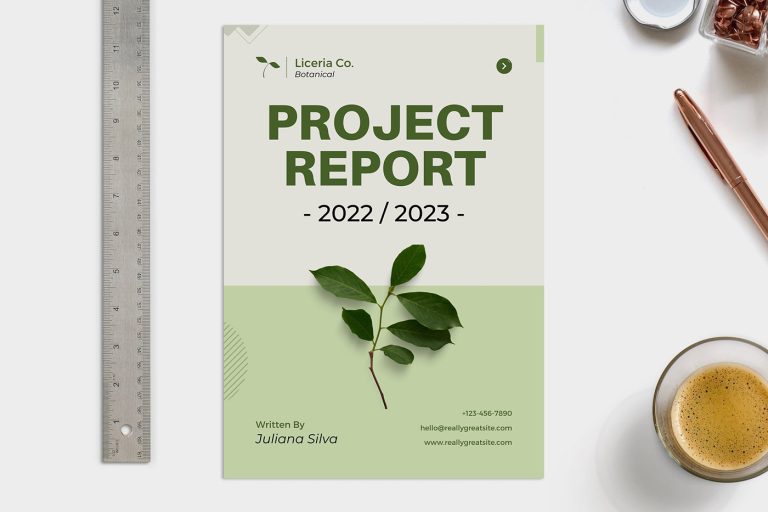
This project report template works well for future projects tied to environmentalism and nature.
Project status report template

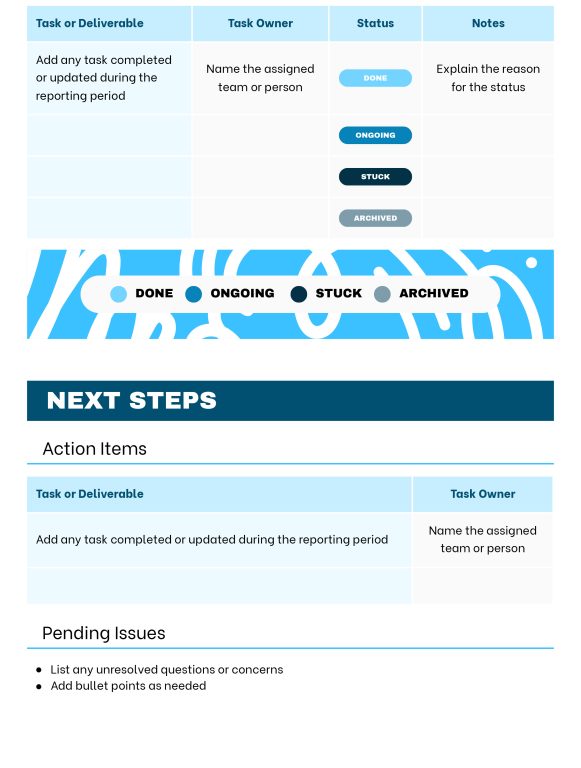
The neutral shades of this project report template can help you create a project report in any industry.
Geometric project report template

You can easily use this template to design a cover for your project reports.
Project evaluation report template
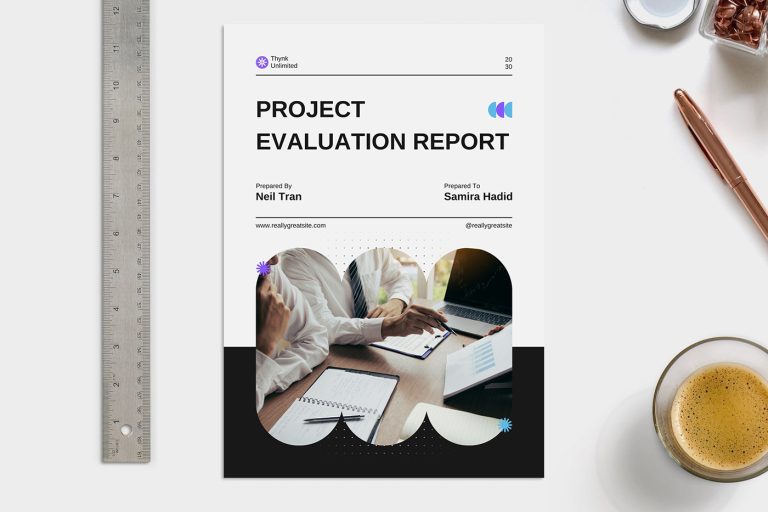
You can use this presentation template to showcase project's progress in a natural, soft way.
Project report modern template
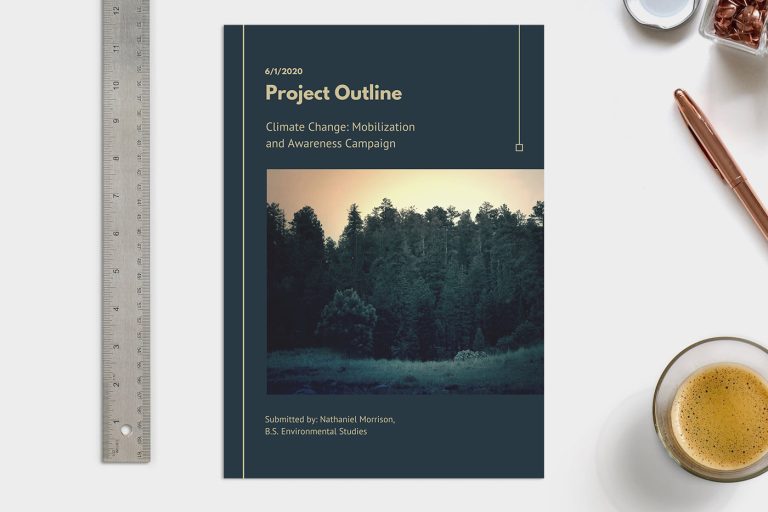
This report template lets you design a respectable-looking project report, working for industries like banking and finance.
Tips for creating a project report
![]() Tip 1
Tip 1
Be honest. Your report must contain accurate and truthful information, discussing both successes and problems. Remember that the report is for the benefit of the boss and employees, not to convince others that you're a great project manager. Be realistic and honest.
![]() Tip 2
Tip 2
Be thorough. Provide all relevant details necessary to understand the project's status. Avoid overwhelming the reader with unnecessary information, though - include only things that are crucial to understanding the state of the project.
![]() Tip 3
Tip 3
Write clearly. Use clear, concise language to make sure your message is easily understood. Avoid jargon or technical terms.
![]() Tip 4
Tip 4
Celebrate success. Highlight accomplishments, milestones and any positive results. This not only motivates the team, but also reassures the project management about the project's progress.
![]() Tip 5
Tip 5
Write for a wide audience. Make sure the report is also understandable to people who may not have knowledge of the project. Provide enough information and context so that everyone understands the progress.
![]() Tip 6
Tip 6
Present the report as a flipbook. Flipbooks from Publuu will help you create professional project reports and publish them online. Include interactive elements and infographics so that your report fully illustrates the data.
![]() Tip 7
Tip 7
Use visuals. Include charts, diagrams, images or other visual aids to more effectively communicate complex information. Visuals can make your report more engaging and easier to digest, especially for sections with a lot of data.
FAQs
Who creates project reports?
Project reports are usually prepared by project managers or teams. The person preparing the status report should know everything relevant about the project and be able to represent both strengths and weaknesses of the project.
Why write a project report?
You write a project report to explain how the project is going and have data you can use when planning the next project. The more specific project data you have, the better. You can use the project report for planning and assessing profitability of future projects.
Who is a project report for?
Typically the reader of the report will be the upper management - who needs a concise summary if your project is going well. Other employees will refer to your project status report in the future, to reflect on the past and improve future timeframes.
When to write a project report?
You write a project status report when the report is ongoing, for example every week or every month. You can end it with a project completion report, detailing anything that happened during project's realization.
Conclusion
Reports are a major part of project management. They keep employees and superiors up to date, help assign tasks and provide the company with useful information. A good report doesn't just let people know what's happening now. It can also help you plan for the future.
Whether you use paper reports or digital flipbooks, your reports need to be clear, honest and understandable to people. By following the tips in our article, you can create great project reports that showcase your team's work.
You may be also interested in:
Marketing Plan – the Complete Guide
